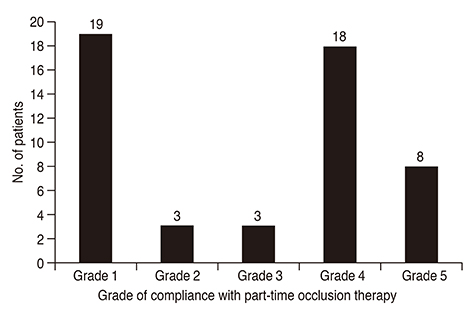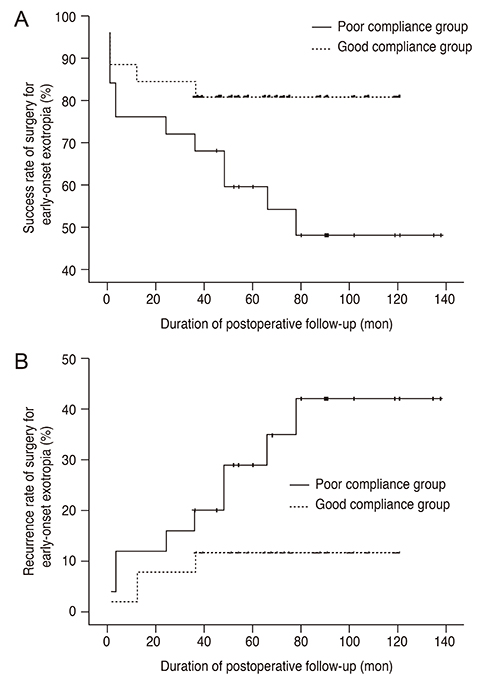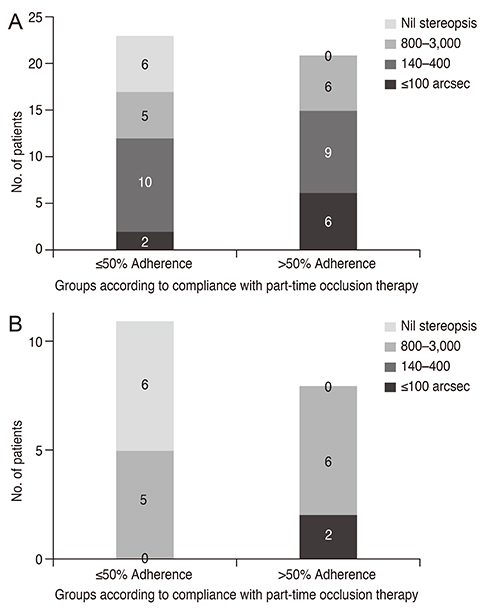Korean J Ophthalmol.
2017 Jun;31(3):268-274. 10.3341/kjo.2015.0168.
The Effect of Preoperative Occlusion Therapy on Long-term Outcome after Surgery for Early-onset Exotropia
- Affiliations
-
- 1Department of Ophthalmology, Gachon University Gil Hospital, Incheon, Korea. hjpaik@gilhospital.com
- KMID: 2379884
- DOI: http://doi.org/10.3341/kjo.2015.0168
Abstract
- PURPOSE
To investigate the effect of preoperative part-time occlusion therapy on long-term surgical success in early-onset exotropia.
METHODS
The medical records of patients who underwent surgery for exotropia with onset before the first year of age and who were followed for ≥3 years were reviewed. Patients were divided into two groups according to the degree of compliance with part-time occlusion therapy: the good compliance group (>50% adherence rate) and the poor compliance group (≤50% adherence rate). Surgical success was defined as orthophoria to exodeviation less than 10 prism diopters both at distance and near. The level of postoperative stereopsis was compared between the two study groups among total enrolled patients and among those with constant exotropia.
RESULTS
Of the 51 patients, 26 were assigned to the good compliance group and the remaining 25 patients to the poor compliance group. The surgical success rate was significantly higher in the good compliance group than in the poor compliance group (80.8% vs. 52.0%, p = 0.040). Among 24 constant exotropia patients (12 patients for each group), the success rate was insignificantly higher in the good compliance group than in the poor compliance group (75.0% vs. 58.3%, p = 0.448). The good compliance group had a better level of stereopsis than the poor compliance group (p = 0.045 for all 44 patients, p = 0.020 for 19 patients with constant exotropia).
CONCLUSIONS
Preoperative part-time occlusion therapy was useful for improving the surgical outcome of early-onset exotropia and postoperative stereopsis.
Keyword
Figure
Reference
-
1. Hunter DG, Kelly JB, Buffenn AN, Ellis FJ. Long-term outcome of uncomplicated infantile exotropia. J AAPOS. 2001; 5:352–356.2. Biglan AW, Davis JS, Cheng KP, Pettapiece MC. Infantile exotropia. J Pediatr Ophthalmol Strabismus. 1996; 33:79–84.3. Yam JC, Chong GS, Wu PK, et al. Prognostic factors predicting the surgical outcome of bilateral lateral rectus recession surgery for patients with infantile exotropia. Jpn J Ophthalmol. 2013; 57:481–485.4. Park JH, Kim SH. Clinical features and the risk factors of infantile exotropia recurrence. Am J Ophthalmol. 2010; 150:464–467.e2.5. Yoo EJ, Kim SH. Optimal surgical timing in infantile exotropia. Can J Ophthalmol. 2014; 49:358–362.6. Suh SY, Kim MJ, Choi J, Kim SJ. Outcomes of surgery in children with early-onset exotropia. Eye (Lond). 2013; 27:836–840.7. Paik HJ, Yim HB. Clinical effect of early surgery in infantile exotropia. Korean J Ophthalmol. 2002; 16:97–102.8. Kraft SP. Special forms of comitant exotropia. In : Hoyt CS, Taylor D, editors. Pediatric ophthalmology and strabismus. 4th ed. New York: Elsevier Saunders;2013. p. 792–800.9. Buck D, Powell CJ, Rahi J, et al. The improving outcomes in intermittent exotropia study: outcomes at 2 years after diagnosis in an observational cohort. BMC Ophthalmol. 2012; 12:1.10. Figueira EC, Hing S. Intermittent exotropia: comparison of treatments. Clin Exp Ophthalmol. 2006; 34:245–251.11. Pediatric Eye Disease Investigator Group. Cotter SA, Mohney BG, et al. A randomized trial comparing part-time patching with observation for children 3 to 10 years of age with intermittent exotropia. Ophthalmology. 2014; 121:2299–2310.12. Buck D, Clarke MP, Haggerty H, et al. Grading the severity of intermittent distance exotropia: the revised Newcastle Control Score. Br J Ophthalmol. 2008; 92:577.13. Raab EL, Parks MM. Recession of the lateral recti: early and late postoperative alignments. Arch Ophthalmol. 1969; 82:203–208.14. Spoor DK, Hiles DA. Occlusion therapy for exodeviations occurring in infants and young children. Ophthalmology. 1979; 86:2152–2157.15. Iacobucci IL, Archer SM, Giles CL. Children with exotropia responsive to spectacle correction of hyperopia. Am J Ophthalmol. 1993; 116:79–83.16. Berg PH, Lozano MJ, Isenberg SJ. Long term results of part-time occlusion for intermittent exotropia. Am Orthopt J. 1998; 48:85–89.17. Suh YW, Kim SH, Lee JY, Cho YA. Conversion of intermittent exotropia types subsequent to part-time occlusion therapy and its sustainability. Graefes Arch Clin Exp Ophthalmol. 2006; 244:705–708.18. Freeman RS, Isenberg SJ. The use of part-time occlusion for early onset unilateral exotropia. J Pediatr Ophthalmol Strabismus. 1989; 26:94–96.19. Chutter CP. Occlusion treatment of intermittent divergent strabismus. Am Orthopt J. 1977; 27:80–84.20. Flynn JT, McKenney S, Rosenhouse M. A method of feating intermittent divergence strabismus (author's transl). Klin Monbl Augenheilkd. 1975; 167:185–190.21. Kim US, Park S, Yoo HJ, Hwang JM. Psychosocial distress of part-time occlusion in children with intermittent exotropia. Graefes Arch Clin Exp Ophthalmol. 2013; 251:315–319.22. Biedner B, Marcus M, David R, Yassur Y. Congenital constant exotropia: surgical results in six patients. Binocul Vis Eye Muscle Surg Q. 1993; 8:137–140.
- Full Text Links
- Actions
-
Cited
- CITED
-
- Close
- Share
- Similar articles
-
- The Long-Term Effect of Part-Time Occlusion Therapy According to Compliance in Recurrent Intermittent Exotropia
- The Effect of Occlusion Therapy on Overcorrected Monocular Exotropia
- The Influence of Monocular Occlusion on the Preoperative Ocular Alignment and the Surgical Outcome in Basic Intermittent Exotropia
- The Surgical Outcome of Intermittent Exotropia with Type Conversion Subsequent to Preoperative Part-Time Occlusion Therapy
- Long-Term Outcome of Surgery for Intermittent Exotropia




